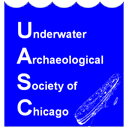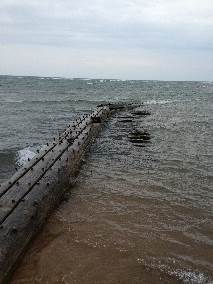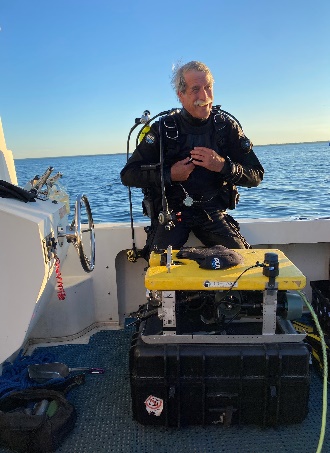Next Meeting: Wednesday, September 25th, 2024, CLICK HERE TO REGISTER
Socialize at 6:30, Business at 7:00, Featured Presentation at 8:00
Zoom Only
***UASC March 2023 MEETING****
Wednesday, March 29th @ 07:00 PM CST – Meeting of Underwater Archaeological Society of Chicago
Featured Presenter: Dan Orr
Presenting: “Mistakes Divers Make+
***THIS MONTH’S MEETING IS ZOOM Only***
On Zoom - Registration Link:
https://us02web.zoom.us/meeting/register/tZwpceCpqzkpE9YpCPLJxQapqk-wAS8eIHXG
Pre-meeting Informal Social; 06:30 – 07:00
Business Meeting; 07:00 – 08:00
Featured Presentation: 08:00 – 09:00 (or later if necessary)
“Mistakes Divers Make"
Dan Orr, President of Dan Orr Consulting, has more than 50 years of diving experiences. He retired from the position of President of Divers Alert Network (DAN) after 23 years where he helped DAN focus on its worldwide diving safety mission. During his tenure at DAN, he assumed a variety of roles including Director of Training (where he was Dan was responsible for the development and implementation of the DAN Emergency Oxygen First Aid Program), Executive Vice President and, ultimately, President/CEO.
Prior to his service at DAN, he worked and taught recreational diving in a retail store, developed and implemented course curricula in the academic environment, and collected data and supervised research efforts in the field of science diving. Dan was certified as a US Navy diver and tested diving equipment for military contractors. He has served and continues to serve in leadership positions on the Board of Directors of many companies and organizations throughout the diving world. Consulting projects have included generating reports on fire safety improvement for liveaboard dive vessels, first aid and accident management improvements on dive vessels and safety management system review and improvements.
Dan has been an invited speaker at numerous national and international diver conferences and conducts regular webinars on a variety of diving safety subjects. He has published and co-authored more than a dozen books and manuals including 101 Tips for Recreational Divers, Scuba Diving Safety, Pocket Guide to First Aid for Scuba Diving Injuries; Pocket Guide for Hazardous Marine Life Injuries; and the DAN Oxygen First Aid for Scuba Diving Injuries Training Manual. He has also published a variety of articles including The Normalization of Deviance (aka shortcut mentality), Time to Return to Diving but Cautiously, COVID-19, Local Diving and The Older Diver, The Ageless Diver, A Crisis Lurking Below the Surface- Emergency Hyperbaric Chamber Availability, Returning the Dive Travel – Be Prepared Part 1 & 2.
***UASC March 2023 MEETING****
Wednesday, March 29th @ 07:00 PM CST – Meeting of Underwater Archaeological Society of Chicago
Featured Presenter: Dan Orr
Presenting: “Mistakes Divers Make+
***THIS MONTH’S MEETING IS ZOOM Only***
On Zoom - Registration Link:
https://us02web.zoom.us/meeting/register/tZwpceCpqzkpE9YpCPLJxQapqk-wAS8eIHXG
Pre-meeting Informal Social; 06:30 – 07:00
Business Meeting; 07:00 – 08:00
Featured Presentation: 08:00 – 09:00 (or later if necessary)
“Mistakes Divers Make"
Dan Orr, President of Dan Orr Consulting, has more than 50 years of diving experiences. He retired from the position of President of Divers Alert Network (DAN) after 23 years where he helped DAN focus on its worldwide diving safety mission. During his tenure at DAN, he assumed a variety of roles including Director of Training (where he was Dan was responsible for the development and implementation of the DAN Emergency Oxygen First Aid Program), Executive Vice President and, ultimately, President/CEO.
Prior to his service at DAN, he worked and taught recreational diving in a retail store, developed and implemented course curricula in the academic environment, and collected data and supervised research efforts in the field of science diving. Dan was certified as a US Navy diver and tested diving equipment for military contractors. He has served and continues to serve in leadership positions on the Board of Directors of many companies and organizations throughout the diving world. Consulting projects have included generating reports on fire safety improvement for liveaboard dive vessels, first aid and accident management improvements on dive vessels and safety management system review and improvements.
Dan has been an invited speaker at numerous national and international diver conferences and conducts regular webinars on a variety of diving safety subjects. He has published and co-authored more than a dozen books and manuals including 101 Tips for Recreational Divers, Scuba Diving Safety, Pocket Guide to First Aid for Scuba Diving Injuries; Pocket Guide for Hazardous Marine Life Injuries; and the DAN Oxygen First Aid for Scuba Diving Injuries Training Manual. He has also published a variety of articles including The Normalization of Deviance (aka shortcut mentality), Time to Return to Diving but Cautiously, COVID-19, Local Diving and The Older Diver, The Ageless Diver, A Crisis Lurking Below the Surface- Emergency Hyperbaric Chamber Availability, Returning the Dive Travel – Be Prepared Part 1 & 2.
Wednesday, January 25th @ 07:00 PM CST – Meeting of Underwater Archaeological Society of Chicago
Featured Presenter: Brian Abbott has over 20 years of underwater engineering inspections, hydrographic surveys and acoustic imaging experience.
Presenting: Acoustic Techniques and Technology for Surveying Shipwrecks
***THIS MONTH’S MEETING IS ZOOM ONLY***
On Zoom - Registration Link:
https://us02web.zoom.us/meeting/register/tZIpcu6vqT8pH9TAF90rnRf3B2-orQXfX-dw
Pre-meeting Informal Social; 06:30 – 07:00
Business Meeting; 07:00 – 08:00
Featured Presentation: 08:00 – 09:00 (or later if necessary)
(Images are from Brian Abbott’s Facebook Page: https://www.facebook.com/brian.d.abbott/photos)
With over 20 years of experience and access to some of the most advanced sonar equipment Brian Abbott does many acoustic images projects around the world including: ports, harbors, dams, bridges, tunnels, shipwrecks and many more objects. He has appeared on Televisions programs such as “Curse of Oak Island”, “Curse of Civil War Gold” and “Ancient Aliens”. He has published articles in professional and academic journals, including: “Journal of Ocean Technology” and “Bridge Design & Engineering”.
He will be speaking on the technology and techniques he uses to image underwater objects including shipwrecks. Techniques will include sector scan sonar, side scan sonar and multi-beam sonar. He will discuss some of his experiences he has had in doing this.
This promises to be a very interesting and educational presentation.
Biography:
Brian has over 20 years of project management, underwater engineering inspections, hydrographic surveys and acoustic imaging experience. He is the owner of Abbott Underwater Acoustics, L.L.C. He is an Engineer and HSE part 1 diver. He was also employed part time by Kongsberg-Mesotech as a special project person. This work includes but is not limited to training on Kongsberg-Mesotech equipment, testing of new prototype equipment and projects from homeland security, bridge inspections, ports and harbors inspections, Brian also does work in the archaeological filed and teaching courses on acoustic systems i.e. Scanning Sonar’s, Side scan sonar, Multibeam system, AUV Systems, Building 3D structures and cloud points underwater. He is also a Level III Nautical Archaeological Society (NAS) Instructor for sonars.
Brian Abbott refers to his infrastructure work as his “bread and butter,” yet he also does a lot of archeological work. In fact, Abbott just recently returned from Virginia where he was looking at shipwrecks from the Battle of Yorktown, the last battle of the American Revolution. Abbott surveys a lot of shipwrecks. He’s captured sonar images from Civil War battles, primarily ironclads, and searched the James River looking for forts or ships that may have been scuttled by the Confederacy during the war. Since 2014, he has also assisted in the search for World War II MIA (missing in action) servicemen throughout the Pacific. “The objective is to find a missing plane, tank, or landing craft underwater,” he says, “so I pack up the sonar gear, fly to an island battle site like Yap, Kwajalein, or Tarawa, where there alone we found twelve different tanks or landing craft underwater that could possibly hold the remains of Marines. It’s a very humbling experience to see these guys who disappeared in 1943 still there. In my world, they need to be brought home. It’s very emotional. There is some family member out there who wonders what happened to their uncle, brother, father, or grandfather, that they still care about. I was out there this year for three weeks looking for fighter planes and B24 bombers. We stop once we find the plane. If we find a component with a serial number on it, we determine who that plane belonged to and that person can be moved from MIA to KIA (killed in action). We don’t excavate remains. We just locate the target and turn it over to the authorities. They can sift through sand, clay and mud and still do genetic testing of one or numerous individuals.” There are still missing Gato class submarines (each with crews of over 60 crew members) as well as lost troop transport ships. In the 20th century alone, from World War I through Vietnam, there remain 80,000 American MIAs—58,000 of those from World War II.
His website is: https://www.abbottunderwateracoustics.net/.
 ***UASC October 2022 MEETING****
***UASC October 2022 MEETING****
Wednesday, October 26th @ 07:00 PM CST – Meeting of Underwater Archaeological Society of Chicago
Featured Presenter: John O'Shea is the Curator of Great Lakes Archaeology at the University of Michigan
Museum of Anthropological Archaeology and Professor in the Department of Anthropology
Presenting: What’s in a Name? Vessel Identification and the Archaeology of Shipwrecks
Meeting timetable:
Social: 06:30 – 07:00 PM CST, Business Meeting: 07:00 – 08:00 PM, Presentations: 08:00 – 09:00 PM CST (or later, if necessary)
In Person at:
CHICAGO MARITIME MUSEUM
1200 West 35th Street, River Level
Chicago, Illinois 60609
773-376-1982
On Zoom:
https://us02web.zoom.us/meeting/register/tZ0vd-6oqzsiGNek9HUnLKmvDc6BJRUFh5PJ
What’s in a Name? Vessel Identification and the Archaeology of Shipwrecks

When a new wreck is discovered, perhaps the single most important task for the researcher is determining the vessel’s name. Once identified, a wealth of historical and contextual information can be linked to the vessel, such as the name of its captain, its cargo, its history, and it’s never reached destination. But what happens when there is no name painted on the transom or imprinted on fixtures? There are numerous examples in the Great Lakes where largely intact wrecks remain unidentified, or even worse, been misidentified. And what about wrecks that have been badly broken up and scattered during and after the wrecking process? At this point, the investigation becomes less a historical problem and more one familiar to archaeologists. In this talk, I will consider shipwrecks as an archaeological, rather than purely historical, problem and consider some methods that are used to determine the identity of lost vessels.
Biography:

John O'Shea is the Curator of Great Lakes Archaeology at the University of Michigan Museum of Anthropological Archaeology and Professor in the Department of Anthropology. He has a BA in Anthropology from the University of Nebraska, a Diploma in Prehistoric Archaeology from Oxford University, and received his PhD in Prehistoric Archaeology from Cambridge University. He has directed major field projects focused on Bronze Age societies in Hungary, Romania, and Serbia, and on late prehistoric cultures in North America. He is also actively engaged in underwater archaeology, where his research involves both historic shipwrecks and submerged prehistoric sites in the Great Lakes.
Thanks,
Scott Reimer
UASC President
Email:
The "Dive Reports" category is a place for individual members to submit reports of their ( local ) shipwreck dives, separate from any survey reports they may submit for particular survey projects. Information of particular interest is the date of the dive, dive conditions, visibility, general condition of the wreck site, and if there were any observable differences from previous dives on the same site.